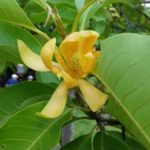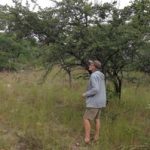TREE LIFE
May/June 2018
Following the AGM, the Tree Society committee would like to say farewell and thank you to retiring committee members Bilal Khatri and Dave Hartung and welcome to new members Ann and Jim Sinclair, Ryan Truscott and Jan van Bel.
– ED
MASHONALAND CALENDAR
Saturday June 2nd: Botanic Garden Walk. Meet in the car park at 0830 hours.
Sunday June 17th: Outing to Domboshawa, courtesy of Jan van Bel. Those of us who visited this beautiful property last time will remember the great diversity of trees and the wonderful views. It is impossible to give directions, so we will meet at the CABS Head Office carpark at 8.45am to share lifts and travel in convoy. The road is quite rough for the last few hundred metres so we will only take high clearance vehicles.
Saturday June 23rd: Visit to Bridgeways complex, Harare, courtesy of Ann and Jim S.
OUTING TO HIPPO POOLS, UMFURUDZI NATIONAL PARK, 21 – 23 APRIL 2018
We set out on Friday to meet up with the group at Hippo Pools’ recently refurbished Lodges and Chalets and camping site. It was so good to meet old friends and acquaintances. Hippo Pools gave us a very reasonable rate for bed and two meals a day. The lodges are set in riverine forest cleared of undergrowth under some very tall trees – Marula, Sclerocarya birrea, some Acacias, Ficus sycomorus and many more with lianas entwined round some of the trunks and branches.
After supper the first evening Meg gave us an outline of the type of woodland in the surrounding park, which was interesting as it includes many of the trees and shrubs found in the Zambezi Valley and Lowveld.
On Saturday morning we were divided into two groups, Meg leading one and Mark the other. We were in Mark’s group with Jenny, Bilal, Graham, Mary, Ryan and his son Sam and Karl. After breakfast we followed Mark, Karl and Tadious, our guide, for a short way by car. On the way, we stopped to look at a parasite in a Pterocarpus brenanii, the Eared Bloodwood. The parasite belonged to the family LORANTHACEAE. In Southern Africa there are 11 genera and about 37 species of Loranthaceae. The plant had striking red flowers and was identified as Oliverella rubroviridis. Seeds are distributed by birds.
Young trees of Pterocarpus brenanii growing in the undergrowth have very large leaves, it is a true legume with the base of the petiole swollen. It has large stipules which fall off later. The fruit is a distinctive round flattened pod.
We turned off the main road and parked nearer the river to walk through magnificent riverine vegetation, where we came across Commiphora africana (Poison-grub Corkwood) with its smooth, grey to green bark that was occasionally peeling in small yellowish flakes. The leaves are trifoliate and margins toothed or scalloped. Young branches are often hairy and spine-tipped. The Ilala or Vegetable Ivory Palm, Hyphaene petersiana, is also prevalent here. This palm is dioecious, with male and female flowers on different plants.
Here is a list of species that our group saw that morning:
Catunaregam taylorii the Thicket-thorn.
Acacia nilotica, which has a very distinct fruit, long green and fleshy when young but becoming dark and drying black and constricted between the seeds, resembling a string of beads. This is the most widespread of Zimbabwe’s acacias though most common at medium altitudes. Acacias are now rather controversially divided into two groups: Vachellia, which has paired straight thorns with globose flowers and Senegalia which have hooked thorns or prickles and, mostly in Zimbabwean species, spicate inflorescences [Note: Many botanical groups including Kew do not accept this name change, where the Australians took (stole!) the name Acacia, meaning ‘thorny’, for their thornless species – Ed].
Diospyros quiloensis, the Crocodile bark, with its distinctive bark and simple shiny leaves, spirally arranged.
Ximenia americana, the Blue Sour Plum. A shrub or spiny tree up to 4 meters in height. The fruit is edible, though rather sour.
Grewia bicolor, which occurs often in dry deciduous woodland at low altitudes and also at medium altitude in high rainfall areas. It is associated with termite mounds and in riverine fringes, has yellow flowers and rounded or 2-lobed fruit. The leaves are dark dull green above and almost silvery white with fine hairs underneath.
Lannea schweinfurthii, the False Marula.
Acacia (Senegalia) nigrescens the Knobthorn. The white flower spikes which appear on leafless trees are one of the first sights of spring.
Terminalia stenostachya, a dominant species here, very striking with trusses of showy red to reddish brown two-winged pods. The bark has deep vertical furrows and stems have conspicuous leaf scars which look like craters.
Terminalia sericea, the Silver Terminalia, with light green to bluish green leaves clustered on the ends of dwarf branches. The slender dark brown or purplish branches peel or flake in rings, they are often parasitised and have round galls of up to 2 to 3 cm in diameter.
Pseudolachnostylis maprouneifolia, the Duikerberry. This is an attractive tree, particularly in autumn when its leaves turn into spectacular autumn colours.
Crossopteryx febrifuga, the Crystal Bark, a member of the coffee family RUBIACEAE. If the dry bark is stripped from a branch, glistening crystals can be seen on its inner surface, which are said to be poisonous.
Colophospermum mopane, which is dominant in vast areas of tropical Africa, often on alluvial soils or on alkaline and poorly drained soils.
Terminalia brachystemma occurs on Kalahari sand in open woodland and around vleis. The bark on the branchlets is dark and peeling, the leaves are paler on the undersurface.
Some of the trees in this woodland were very tall, large and impressive, namely an Acacia nigrescens, a Pseudolachnostylis maprouneifolia, and a magnificent Kigelia africana full of large fruit.
Philenoptera violacea the Raintree, which does ‘rain’ for a week or so in the hot dry season, the ‘rain’ caused by the nymph of a small insect. They obtain nourishment by piercing the bark, sucking up sap very fast and ejecting almost pure water at the same rate.
Acacia goetzei, a woodland species with medium-sized rounded leaflets.
Dalbergia melanoxylon Zebrawood. The sapwood of this species is yellow to white surrounding a very hard, purplish heartwood which turns black on exposure. It is of considerable commercial value if the pieces are of reasonable size. However, because of slow growth, the trees are usually small and the stems twisted. Therefore, it is often only used for small ornaments, chessmen and woodwind musical instruments.
The Marula, Sclerocarya birrea, is a small to medium tree which can reach 15 m under favorable conditions, such as those found at Hippo Pools. The sexes can be separate on separate trees or on the same tree. Fruit is fleshy, round, yellow when mature and can be made into a potent alcoholic drink. A good amber jelly can also be made from the fruit.
Holarrhena pubescens, the Jasmine tree, is a low altitude small tree with pure white jasmine-scented conspicuous flowers. The fruit forms paired follicular carpels that are long and very slender, up to 30 cm x 0.4 cm, dark green and dotted with lenticels.
Artabotrys brachypetalus the Purple Hook-berry, is a common climber climbing by distinctive curling flower stalks.
The River Litchi, Lecaniodiscus fraxinifolius. These are often badly damaged by elephants.
Allophylus africanus, the African False Crowberry.
Grewia flavescens, the Donkeyberry. Its bark has fluted ridges, while the trunk and larger branches are square. Flowers are yellow and form a fruit that can be 2- or 4-lobed.
Diospyros senensis, the Peeling Bark Diospyros, and an unidentified Combretum were also seen, while Mark took a specimen of an unusual creeper with distinct wavy leaves.
Gymnosporia senegalensis, commonly called the Confetti tree or Red Spike thorn, with its leaves large and green, not as grey as those seen in the Harare area.
Ficus capreifolia, the Sandpaper Fig, is often a shrub along river banks. The very harsh leaves were used as sandpaper in the preparation of hides and finishing the wood on bows. We also came across Ficus sycomorus.
We completed the morning with a Combretum collinum, a small to medium sized tree.
Sunday 22nd April
We set off in same group but towards the kopje behind the lodge, into an area of Miombo woodland. Interestingly no one has found a Musasa, Brachystegia spiciformis, at Hippo Pools. [The common Brachystegia here is B. boehmii, which is found at lower altitudes than B. spiciformis. –Ed]
Our first stop was at a tree being strangled in very tight snake-like coils by the creeper Opilia amentacea. The leaves are brittle and break when bent.
Gardenia ternifolia, the Powderbark Gardenia, is a shrub or small spreading tree. The bark is grey or yellowish brown, smooth and powdery. The flowers are an attractive white, ageing to yellow.
Karl recognised a pile of civet dung, called a civetry. It was clear that these shy animals eat millipedes, – chongololos – because rings of the carapace were visible in the dung.
Acacia goetzei, whose leaflets look like a smaller version of Acacia nigrescens.
Margaritaria discoidea: the appearance of this tree varies according to its habitat. In wooded grassland it is a shrub or small tree, in evergreen forest it can reach 20 m in height.
Ormocarpum kirkii, the Small Caterpillar pod.
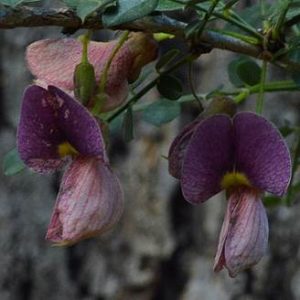
Ormocarpum kirkii flowers
Several grasses were discussed namely Loudetia and Heteropogon contortus (spear grass).
Diospyros kirkii, the Pink Diospyros, is a small tree found in open woodland on sandveld. Flowers are pinkish and the almost spherical fruit form a highly esteemed food.
Julbernardia globiflora, Munondo, is often co-dominant with Brachystegia spiciformis in large areas on the Highveld, but here it is alone and fairly dominant.
Ximenia americana, the Small Sour Plum, with leaves that are smooth and found in the axils of straight thorns.
Canthium glaucum, Pink-fruited Canthium, belongs to the coffee family RUBIACEAE, with straight, chocolate-coloured spines up to 2 cm long, in a decussate arrangement.
We also found Euclea divinorum, Diamond-leaved Euclea, as well as Commiphora africana, an unidentified Grewia sp, and Combretum hereroense the Mouse-eared Combretum. Next to these was Colophospermum mopane with a tree orchid, Ansellia africana, growing on it – this orchid can survive very dry conditions.
Carissa spinarum (formerly C. edulis) is an important food for rhino.
Sterculia africana, the Tick tree, produces a gum, but not in enough quantities to be commercially viable. The fruit is boat-shaped and split down one side only, golden and velvety on the outside, with its mouth fringed with bristly, very irritating hairs. The blue-grey seeds are about 2 x 1cm, attached round the edge of the opening and resembling engorged ticks, hence the name.
Next was Senna singueana, the Winter-flowering Cassia and Crossopteryx febrifuga, the Crystal Bark, followed by Cissus cornifolia, Ivy-grape, Bridelia cathartica, Knobby Bridelia and Diospyros kirkii. We saw all the above while walking by the side of one of the kopjes and then came across a damp area of black soil, well grassed, with flowering herbaceous plants including Dolichos kilimandscharicus from Kilimanjaro and Waltheria indica with small tight flowers. The grass Themedra triandra is an indicator of good grazing. More flowers among the grass included – a Lamiaceae with flowers in the axils of leaves; the calyx is swollen to a case with four nuts. We also saw Dalbergiella nyasae the Mane Pod.
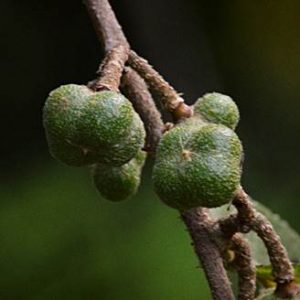
Grewia flavescens fruit
Flacourtia indica, the Governor’s Plum, is a very variable plant occurring over a wide area from sea level to about 1,600 m. In autumn the leaves turn a brilliant red, plum-coloured to purplish black.
We were lucky to find one Gardenia ternifolia with fruit. This species has raised tufts of hairs (domatia) in the axes of the veins on the upper surface of the leaf.
Other trees included: Albizia versicolor the Poison Pod Albizia, Tinnea rhodesiana, Dyschoriste hildebrandtii (white flowers), Vernonia muelleri (blue flowers), and Hypericophylum compositarum (bright orange flowers); Pleurostylia africana the Northern Coffee Pear and Ozoroa reticulata (the Tarberry), whose fruit is kidney shaped and hanging in bunches like dried raisins. Ximenia caffra has rusty hairs when young.
The next section of the walk was a fairly steep climb up a rocky path to find Pseudolachnostylis maprouneifolia and Antidesma venosum, the Tasselberry, with male and female flowers on different plants. The fruit of this species is spectacular, in long pendulous spikes, that are white when young turning to red and finally purplish black when mature.
We then turned back to the cars and drove back via the dam. Thank you, Mark and Karl and Tadious for a most informative and interesting few days.
– Ann Sinclair
OUTING TO JANE L’s PROPERTY, UMWINZIDALE, SATURDAY 27TH MAY 2018
This was a delightful venue and we are grateful to Jane for sharing this with the large group of members who ventured out on this lovely Saturday afternoon. Was it comments that had been made about whether it was worth having Saturday afternoon outings or the fact that this particular property had historical Coates Palgrave connections, Mrs. Olive Coates Palgrave of Tree of Central Africa fame having once owned the property, we will never know but it was good to have twenty-one members with us to enjoy the afternoon. Especially good to see Claire and Mike and Liz.
Jane and her family came to live at this home in Umwinsidale in 1984 and the trees that were there are mostly still there; she has planted only a few during the time that she has lived there. Incidentally, the road name came about because the Palgraves lived on one side of the road and the Hollands on the other, Jane describes it as a sleepy little hollow, which it was in those days.
My thanks to Barbara for recording species seen on the lower part of the property. On the top lawn were several very large musasas, Brachystegia spiciformis, which were playing host to large clumps of Ansellia africana or Leopard Orchid, and several other small indigenous orchids; they obviously thrive in this situation.
The group started by looking first at Crabia brevicaudata and then Croton megalocarpus, the Kenya Croton. The Cordia africana next to them was still flowering, always such a spectacular sight when in full flower and then in great demand by the birds when it is fruiting. Next to this was a Dais cotinifolia, the Pom-pom tree, another delight when in flower with its pink pompoms. It is native from Tanzania southwards, through Malawi, Zimbabwe, South Africa, Swaziland and Lesotho, growing best along forest or riverine margins.
Then came Sterculia africana (probably) and Ficus lutea, with its stipules at the end of the growing tip which then leave a scar around the stem. Next to it was a species of Podocarpus, probably not the indigenous one, that was taken for identification, as was the next tree, possibly a Widdringtonia?
The new name for Philenoptera violacea (the Rain Tree) always sounds so foreign, compared to Lonchocarpus capassa. Maybe I will get used to it but somehow I doubt that my old brain will ever associate this beautiful tree when it is in flower with the new name.
Close by were Combretum zeyheri (Large Fruited Bush Willow), Fernandoa magnifica, Albizia gummifera and Afzelia quanzensis (Pod Mahogany) – what a lovely corner of the property this must be when everything is flowering. Nearby were Combretum erythrophyllum, River Bush Willow, an unknown species of Syzygium and a Pterocarpus brenanii, (Large-leafed Bloodwood) together with a Gardenia ternifolia (Large-leafed Common Gardenia or Small Wild Gardenia).
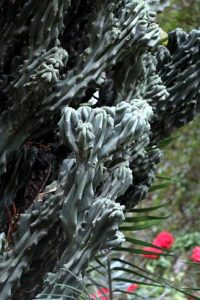
Cereus peruvianus f. monstrose (exotic Monstrose Apple Cactus). Photo Mark Hyde
Tony identified a strange looking succulent as Cereus peruvianus f. monstrose (Monstrose Apple Cactus) – a naturally occurring mutant succulent that grows up to 4.6m, with irregular texture and branching habit that gives it a fascinating sculptural quality. The flowers, which open at night in early summer, are white. One’s imagination could run away when trying to imagine this! However, on looking it up I find I have several in my garden and it does not sound nearly so intimidating now.
There was a huge Anthocleista grandiflora, (Forest Fever Tree) growing in the garden. This is the southern African dicotyledonous tree with the largest simple leaves, up to 1,000 x 3,000mm. (info. Van Wyk & van Wyk). It is growing very well in that garden, despite not being in a forest.
Other trees seen were the exotic, showy Senna spectabilis which is flowering everywhere now; Celtis africana (White Stinkwood); an unknown species of Albizia with white flowers, a possible Nuxia floribunda (Forest Elder) and a species of the red-flowered Calliandra, with a Salanum seaforthianum climbing on it.
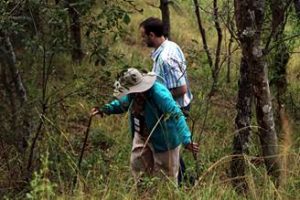 At this stage most of the group opted to sit and enjoy much needed tea and coffee, as well as the magnificent spread of food put out by Jane.
At this stage most of the group opted to sit and enjoy much needed tea and coffee, as well as the magnificent spread of food put out by Jane.
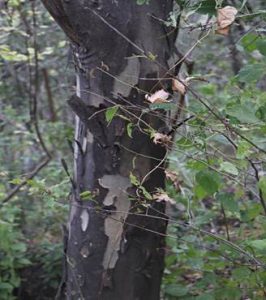
Stereospermum kunthianum (Pink Jacaranda) trunk
The “real athletes” including Meg went up the kopje behind the house to see if they could find the Stereospermum kunthianum – and they were rewarded for their efforts.
Jane not only provided the venue but also gave us a sumptuous tea at the end. Our thanks to Jane and to her son Ross for guiding the group up the hill to identify the large Pink Jacaranda together with several little ones, these must be a sight when in flower.
A very pleasant afternoon indeed. Thanks to all who made it so – Tony, Jim and Ann, Dawn, Mark, Jane, Meg, Ross, Mary, Graham, Alex, Isla, Liz, Teig, Barbara (for the list of trees), Peter, Debbie, and Claire and Mike (sorry if I forgot you, my memory fails).
– Mary Lovemore
TONY ALEGRIA CHAIRMAN


